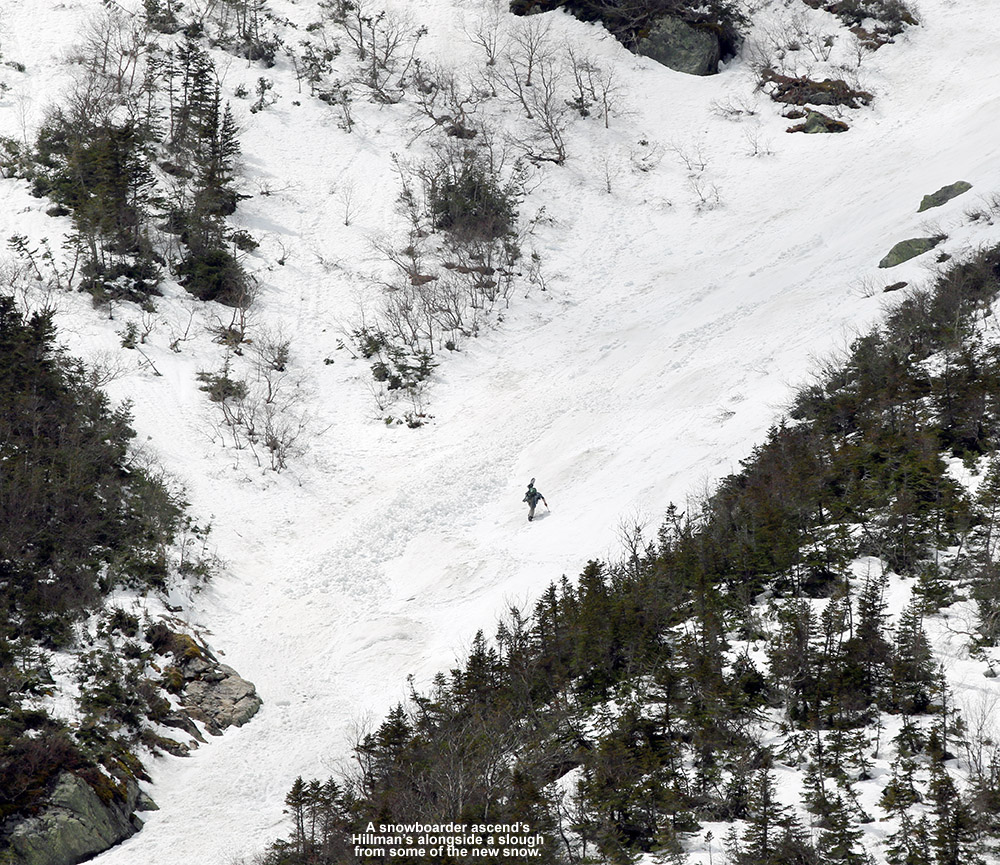With our latest stretch of cool, early autumn weather, many valley locations have been seeing low temperatures in the 40s and even 30s F. Mount Washington in New Hampshire was even reporting freezing drizzle with a temperature of 30 F yesterday morning. Today there was some video of flakes at Jay Peak, which I believe are the first of the season I’ve seen reported here in Vermont. It looks like we have some nice warm fall days ahead, but Vermont’s 2024-2025 snow season is officially underway.
First Vermont snows for the 2023-2024 winter season
Today we got our first taste of the coming winter in the Northern Green Mountains. While Mt. Washington in New Hampshire has had a number of rounds of snow thus far in the autumn, and there were some reports of possible frozen precipitation in far northern Vermont a week or two ago, today saw the first notable accumulating snow on Mt. Mansfield. As of midafternoon today, Powderfreak reported that the snow level was down to ~2,500’, and he sent in an image of a half inch of accumulation at 3,000’ as of 3:30 P.M. By early evening he provided a few more pictures and indicated that the snow level had dropped below 2,000’. Up at the Mt. Mansfield Stake at roughly 3,700’, the report was that there was about an inch of accumulation over a third of an inch of ice. A check of mountain webcams around the area revealed that just about all the mountains were seeing flakes with accumulation, but those views will have to do for now. Unfortunately, it’s been far too cloudy to get any nice shots of the snowy peaks from afar, but hopefully we’ll get to see them appear in a day or two.

So, Oct 22 will go down as the date for our first accumulating Mt. Mansfield snow for the winter of 2023-2024, and we can now add it to the books and see how it compares to the averages. The stats for first accumulating snowfall of the season on Mt. Mansfield are below for comparison – today’s date of Oct 22 is later than the mean date of Oct 11, but well within 1 S.D., so quite normal in that regard. Assuming a normal distribution, about 25% of seasons will have later first snowfall dates than this one.
The dates of first accumulating Mt. Mansfield snow for some recent seasons are shown below as well, so this season sits later than the past few, but ahead of most of that stretch in the mid-2010s, which was a surprising run of later October dates.
Date of first accumulating Mt. Mansfield snow:
Mean: 10/11
Median: 10/10
Mode: 10/17
S.D.: 15 days
N: 67
Most Recent: 10/22
Most Recent Days Deviation: +11
Most Recent # of S.D. Deviation: +0.732
Most Recent S.D. % Lower: 76.8%
Earliest 8/28/1986
Latest 11/17/1985
Date of first accumulating Mt. Mansfield snow by season:
2008: Oct 3
2009: Sep 30
2010: Oct 7
2011: Oct 30
2012: Oct 8
2013: Oct 24
2014: Oct 26
2015: Oct 17
2016: Oct 26
2017: Oct 27
2018: Oct 13
2019: Oct 18
2020: Oct 17
2021: Oct 18
2022: Oct 8
2023: Oct 22
Potent October snowstorm hits parts of Northern New England
On Tuesday, a fairly compact low pressure system formed off the New England coast and spread snowfall back into parts of Northern New England. During the afternoon, mixed precipitation was falling at roughly the 1,500’ elevation near the bases of local resorts like Sugarbush and Stowe, with the accumulating snow line around 2,000’. At the end of the day, Powderfreak sent in a nice picture to the NNE thread at the American Weather Forum showing the snow line at Stowe’s Gondola area.
The most impressive accumulations came on Tuesday night, with Wednesday morning revealing 5.1 inches in Derby Center, VT, 7 inches at Pinkham Notch, 11 inches of new snow in Randolph, NH, 17 to 18 inches in Tuckerman Ravine, and 18 inches atop Mt. Washington at the observatory. Wildcat ski area picked up roughly a foot of snow and plans to open on Saturday with top-to-bottom skiing. Back here in along the spine of the Northern Greens, Powderfreak was reporting 3 to 4 inches of snow for the upper elevations of Mt. Mansfield by Wednesday evening.
As of this evening, we picked up a bit of accumulation at our house in Waterbury, and Powderfreak was reporting a general 3 to 5 inches of total snow accumulation on Spruce Peak at Stowe.
There’s apparently a Nor’easter brewing for this weekend, although there’s not a ton of cold air around for the system to use, so the current forecast suggest snow will only be up near the summit elevations and fairly limited in amount.
Mt. Washington, NH 16MAY2017

As the spring semester winds down, many of our graduating biochemistry majors here at UVM have been getting out to enjoy the remaining snow in the mountains of both New Hampshire and Vermont. I’ve been hearing some fun reports, so when Rob invited me to join one of their Mt Washington adventures, I was definitely interested. His plan was for the Tuesday of senior week, weather permitting of course. My schedule looked good, so I was hopeful for the chance to commune with some of the seniors in the great outdoors before they’d begin departing after graduation.
“We could see that there had been some sloughing there due to the new snow, but the lower areas we could see looked quite settled and stable, and there had already been plenty of skier traffic in the gully.”
Mother Nature threw some rather interesting weather into the mix ahead of the planned trip, with Mt Washington picking up almost 3 feet of new snow at summit elevations over the past couple of days, and over a foot down at Hermit Lake. That was a lot of new snow, and the avalanche report suggest that northerly winds would be loading the more southerly-facing gullies and cross-loading the east-facing ones. Temperatures were expected to rise significantly today, which we knew would result in plenty of settling depending on elevation. There seemed to be enough potential to find at least some level of safe skiing, so we decided that we’d check with the staff on scene in the Hermit Lake area, and the trip was on.
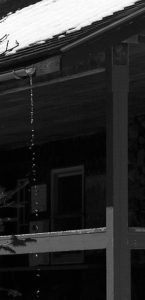
Only Rob and Emily ended up being able to make the trip, but I met them at the Pinkham Notch Visitor’s Center, and after getting our gear together, we were on our way. I’ve hiked up to the Tuckerman Ravine area many times, but with the new snow I decided to try a gear setup that I’ve never used before. Instead of brining two pairs of boots (hiking boots and ski boots), I wanted to just wear my mid-weight Telemark boots for everything, hiking and skiing. It turns out that the setup worked great; my Garmont Gara boots have got rubber Vibram soles so they were plenty comfortable and pliable on the ascent through a lot of dry, rocky terrain. Ascending from Pinkham Notch at ~2,000’, we saw our first signs of snow at 2,650’, and at around 3,400’ the snow cover was continuous enough that I was able to start skinning there and made it right up to Hermit Lake. The new foot or so of snow had certainly helped with the potential for skinning – coverage would have been somewhat less continuous on that last part of the ascent without it.
We assessed the snow/ski terrain situation from there, and while most of Hillman’s was visible with clouds just skimming the upper reaches, Tuckerman Ravine was generally socked in. After consulting with the staff at Hermit Lake, and using what we could see, we decided that Hillman’s Highway was the way to go. Most skiers we encountered seemed to be making the same decision. We could see that there had been some sloughing there due to the new snow, but the lower areas we could see looked quite settled and stable, and there had already been plenty of skier traffic in the gully.
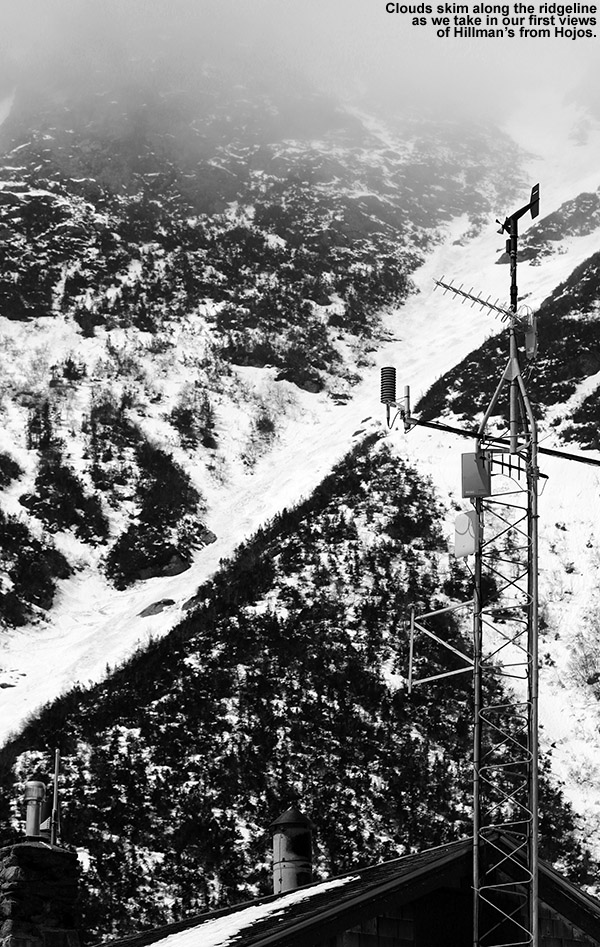
Emily and I skinned up the first part of gully, but around halfway it was just getting too steep and we had to switch to hiking. Thankfully there was a nice boot ladder already in place on climber’s right. I stopped around mid-gully where I figured I’d still get plenty of descent, and set myself in a good position with my camera. Emily and Rob headed up to where the gully splits into a Y, and went a little farther up the climber’s right option before settling down in a sheltered area of rocks. Above that point the snow hadn’t been skied and was a little questionable, and in that regard they were on the same page as other folks skiing in the area.
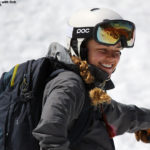 The best skiing was in areas where there had been some skier traffic that got down to the older corn snow surface, and the toughest turns were in the mush that had settled down near the bottom of the gully. The Sherburne Ski Trail had actually opened back up a bit with the new snow, and we were able to ski about a third of it before we had to cut back to the hiking trail. After that the descent was quick, and we were back at the cars saying our goodbyes.
The best skiing was in areas where there had been some skier traffic that got down to the older corn snow surface, and the toughest turns were in the mush that had settled down near the bottom of the gully. The Sherburne Ski Trail had actually opened back up a bit with the new snow, and we were able to ski about a third of it before we had to cut back to the hiking trail. After that the descent was quick, and we were back at the cars saying our goodbyes.
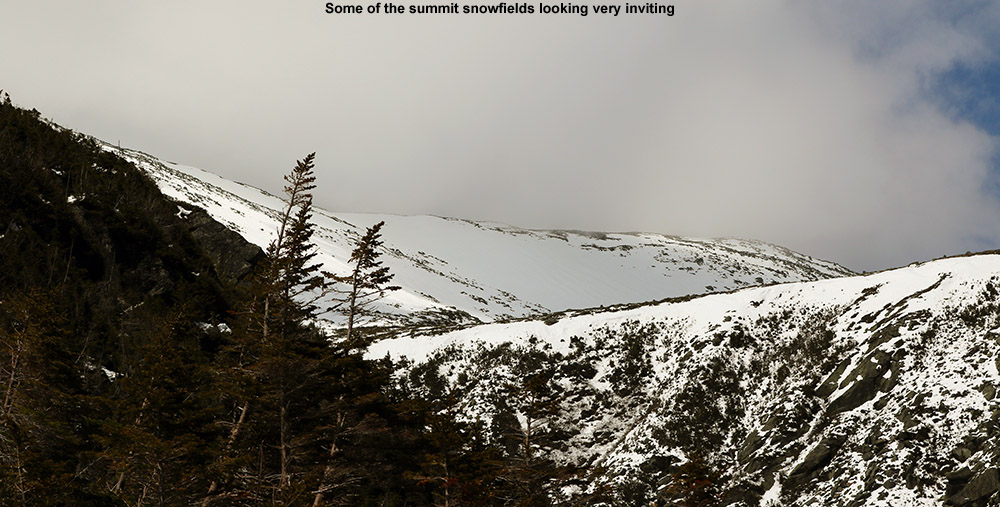
The new snow is going to get even better with a couple of freeze-thaw cycles, and it’s certainly bolstered the snowpack somewhat in the higher elevations. Although they were in and out of the clouds, the summit snowfields looked really nice, so there should eventually be some excellent skiing up there with easy access as soon as the road opens back up.
Another round of Northeast snow
In the Northern New England thread at the American Weather forums this morning, there have been various reports and pictures of snow from the high peaks throughout the Northeastern U.S. I saw pictures of frozen white from Sugarloaf Mountain in Maine, Mt Washington in New Hampshire, Mt. Mansfield in Vermont, and Whiteface Mountain over in New York. This is at least the second round of snow for some of the higher peaks, with hopefully more to come as we head through the fall. Head to the forum link at the beginning of the post to check out the images of this latest Northeast snow.
Vermont Snow: First of the season
We’ve been hearing mentions of snow in the recent weather forecasts, mostly about how we’re getting close to those temperatures where the mountains can start to see flakes, and today I saw the first reports of snow up in the higher elevations. One of the engineers manning the broadcast equipment up on Mt. Mansfield snapped a picture of some of the flakes falling to document the first Vermont snow of the season. It’s not too surprising, with Mt. Mansfield close to the freezing mark this morning along the ridge line. A bit higher up, the summit of Mt. Washington in New Hampshire is sub freezing at this point. It’s October now, and although it looks like we’ll have plenty of nice weather coming over the next week, it’s the time of year when the mountains can start getting snow at any time, so we’ll be on the lookout for upcoming snow chances.
Mt Washington, NH 08JUN2014
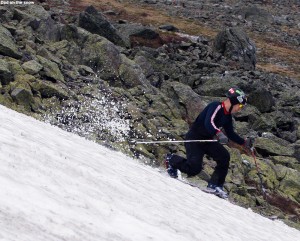
Since the end of the school year was keeping E rather busy last weekend, the boys and I just made a quick day trip out to ski the Mt Washington snowfields on Sunday. The turns were good, and with things lightening up for E by this weekend, we again kept our eyes on the weather for some possible camping and skiing. The forecast ultimately looked even better than it did for last weekend, suggesting warm, dry weather both Saturday and Sunday, so we packed up and headed off to New Hampshire yesterday around midday.
“…Ty started banging out
runs pretty quickly on that
upper section because he
really liked the short hike
back up.”
We set a course for the Glen, NH area to see if we could get a site at the Glen Ellis Family Campground similar to what we’d had last spring. We’d never been to the campground before that trip, but we really liked the riverside campsite we had along the beautiful Saco River. Since the Sunday forecast looked even a bit better than Saturday with respect to the potential for clouds and wind, we headed right to the campground yesterday and found that they had a number of the riverside campsites available, even ones with electrical power, which we find great for charging up various mobile devices. It was a warm afternoon in the 80s F, and tubing on the river was a popular activity. They’ve really got a great setup there for running laps in the river; you just ride down as far as you want, and walk your tube back up along the edge of the campground. We spent a chunk of the afternoon working on Dylan’s throws and playing some disc golf in the campground’s massive grassy fields. After we’d spent so much time practicing, it was great to see how often Dylan was able to hit the disc golf basket. We then had dinner at the campsite, and finished off the day with some evening exploration of the shoals and islands in the river. Dylan discovered that the campground had Wi-Fi, and we had an excellent signal even all the way out by the river, which is almost a half mile away from the main office. They must have an impressive wireless setup to be able to span the 65 acres of their campground. I did a test on Speedtest.net and found that the upload and download speeds were both 1.0 Mbps, which is plenty of bandwidth unless you need to stream video or do something similarly intensive.
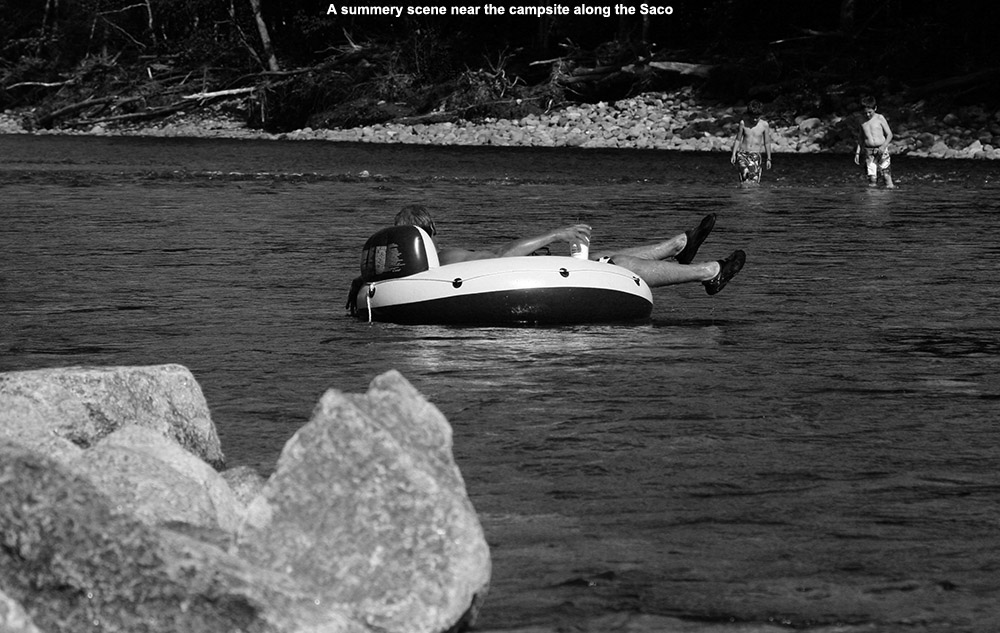
This morning we had breakfast, gradually broke down the campsite, and headed north on Route 16 for the quick trip to the Mt Washington Auto Road. Thanks to the available Wi-Fi at the campsite, I was able to do a check on the Ravines Cam to see the current state of the snowfields. It was clear that the main Ball Crag Snowfield had lost a lot of snow in its middle sections, and the snow had the look of a backwards letter “C”. The main area of the East Snowfields had broken up a lot, such that largest remaining section didn’t seem to have much more vertical than what seemed available on the Ball Crag Snowfield. With that information and our knowledge from last week about the ease of access, we decided that the Ball Crag Snowfield area was still probably the best bet for today’s trip. After reading another trip report at the Time For Tuckerman Forum last week in which someone monitored their gas mileage up the Auto Road, we decided to monitor ours, and found that it was right around 9.0 MPG up to the 5,700′ parking area in the Subaru; since the other report indicated that they managed 10 MPG in a hybrid vehicle, and we were loaded with four passengers and lots of camping and ski gear, I guess that’s not too bad. Presumably there’s not much gained in a hybrid on a long, continuous climb like the Auto Road, but whatever vehicle it was, it’s likely to be a fuel efficient one anyway. As we unloaded our gear, one of the Mt Washington Auto Road Coaches passed by, and the driver reminded us to make sure we stayed on the rocks so that we didn’t harm any of the fragile alpine flowers and other vegetation. I hadn’t seen much vegetation flowering last week, but he noted that some of the flowers were just starting to make their way up to these elevations now. It actually wasn’t as sunny as we thought it might be, and gray clouds almost looked like they might throw down some precipitation, so everyone packed light shells in their packs just in case. Being just a few minutes from the car, we find that one can pack minimally if they want to, but if rain really came down, we’d want to have something on hand.
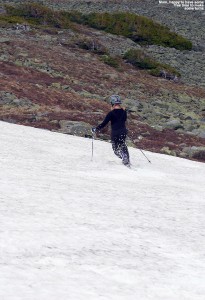
It was again a short trip to the snowfield, and we could start to get a sense for how what the ski options were going to be. Since last week, we could see that there hadn’t been too much change in the areal snow coverage in the upper section of the snowfield, but the lower section showed dramatic differences due to the past week’s melting. The lower section was much smaller, and the snow was no longer continuous into that area. That made laps in the upper section most practical, and Ty started banging out runs pretty quickly on that upper section because he really liked the short hike back up. E slid out a bit on her first run and even got into the rocks at the bottom, but she was OK – it was definitely the most dramatic encounter with the rocks we’ve seen though, even more than when Dylan got into them a little bit last week. We often talk about how much we really need our helmets on these outings on the snowfields, since there are rarely other skiers around, but E’s slide was another great example of why we make sure to wear them. As she was sliding, even though she was in good shape being feet first, she was very happy to know that she had that helmet on. Ty kept cranking out the runs, and even Dylan whipped out a couple of quick runs before taking a break. I started to make some runs to see if I could catch up to Ty, but every time I’d take a run, he would do another with me, so there was no catching up that way. He was having fun with that, knowing that as long as he did a run every time I did, there was no way that I’d be able to catch up. It made for some fun runs where he worked on mirroring my turns, and although I couldn’t see him while we were skiing, now that I look at some of the photos, I can see he was doing a really nice job. For our last run, Ty and I connected down to the lower snowfield for a few extra turns on our way to hike out, so in the end we called it an extra quarter run, so Ty wound up with 7 ¼ runs to my 4 ¼ runs, with Dylan at 3 runs and E at 2 runs. We joked with Ty that he didn’t even do as many runs as the rest of us, because before that last run, he was quite proud that he had! The sky remained with one and off gray and sometimes fluffier clouds, with the occasional break of sun, and fortunately there were no signs of any precipitation.
The boys had wanted to head up to the summit of Mt Washington and visit the Sherman Adams Summit Building on our last outing, and we didn’t really have time, but this time we’d planned on it, so we stopped in at the visitor’s center for a while. We used our tickets to the new exhibit area in the museum, which is focused on the extreme nature of Mt Washington in the winter, and indeed it has been heavily updated relative to what was there before. The whole area seems very new and modernized all around, and there’s some impressive use of high-definition screens and other video technologies. It’s certainly worth a visit to the new exhibit if you have not seen it since it’s opening in May. We stopped in Gorham for a bite on the way home, and ate at one of the picnic benches on the Gorham Town Common, where the boys hit the playground for a bit. I’d say that’s just about it for the snowfields this season, so most of the activity will be shifting to Tuckerman Ravine. For some strange reason, the availability of snow only seems to decrease this time of year!
Mt. Washington, NH 01JUN2014
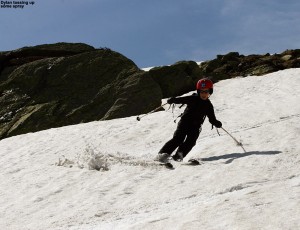
Last weekend’s weather was a bit too dicey to get us to head over to Mt. Washington for skiing, but the forecast for good weather this weekend was looking pretty solid. E was feeling the need to get other work done with the end of the school year closing in, so the boys and I decided to just go for a day trip to the snowfields. Typically we throw in some camping in the White Mountains as part of our Mt. Washington ski trips, so this would be the first time in a while that we’d be doing the out and back in a day. It’s actually just a couple hour trip to get over to the base of the Mt. Washington Auto Road from our place in Waterbury, so day tripping is certainly practical, but breaking up the driving with some camping has been the routine these past few seasons.
“The snow was great, being a bit harder in a few spots, and a bit softer in others, but the bulk of it was just right for making turns.”
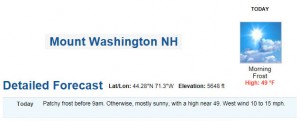 I did a final check on the forecast for roughly the 5,500’ level on Mt. Washington this morning, and it called for leftover frost, clear skies, a high around 50 F, and light winds in the 10-15 MPH range. That’s an excellent forecast for some skiing in Mt. Washington’s alpine areas, and it’s good to jump at these sorts of days, because you never know what the next one will bring when it comes to the Mt. Washington and the Presidential Range. The boys and I headed out around 9:00 A.M. under blue skies and temperatures in the 60s F, and by midday we were up in the parking lot along the Nelson Crag Trail at ~5,700’ getting our gear together. The weather was great, and the numbers on the board showing the summit weather conditions had been right in line with what the forecast suggested. After checking the images from the Ravines Cam over the past few days, as well as this morning, I could see that one of our favorite snowfield areas below Ball Crag was of decent size, so that was our planned destination. We like that Ball Crag snowfield because it doesn’t see nearly as many visitors as the main East Snowfields below the summit, and instead of having to park above it and hike down into the snow, you can contour right across from the parking area along the Nelson Crag Trail. It can be a bit harder to find some of those lower snowfields if you’re not familiar with the area, but we usually have good luck traversing out from near the junction of the Nelson Crag and Huntington Ravine Trails.
I did a final check on the forecast for roughly the 5,500’ level on Mt. Washington this morning, and it called for leftover frost, clear skies, a high around 50 F, and light winds in the 10-15 MPH range. That’s an excellent forecast for some skiing in Mt. Washington’s alpine areas, and it’s good to jump at these sorts of days, because you never know what the next one will bring when it comes to the Mt. Washington and the Presidential Range. The boys and I headed out around 9:00 A.M. under blue skies and temperatures in the 60s F, and by midday we were up in the parking lot along the Nelson Crag Trail at ~5,700’ getting our gear together. The weather was great, and the numbers on the board showing the summit weather conditions had been right in line with what the forecast suggested. After checking the images from the Ravines Cam over the past few days, as well as this morning, I could see that one of our favorite snowfield areas below Ball Crag was of decent size, so that was our planned destination. We like that Ball Crag snowfield because it doesn’t see nearly as many visitors as the main East Snowfields below the summit, and instead of having to park above it and hike down into the snow, you can contour right across from the parking area along the Nelson Crag Trail. It can be a bit harder to find some of those lower snowfields if you’re not familiar with the area, but we usually have good luck traversing out from near the junction of the Nelson Crag and Huntington Ravine Trails.
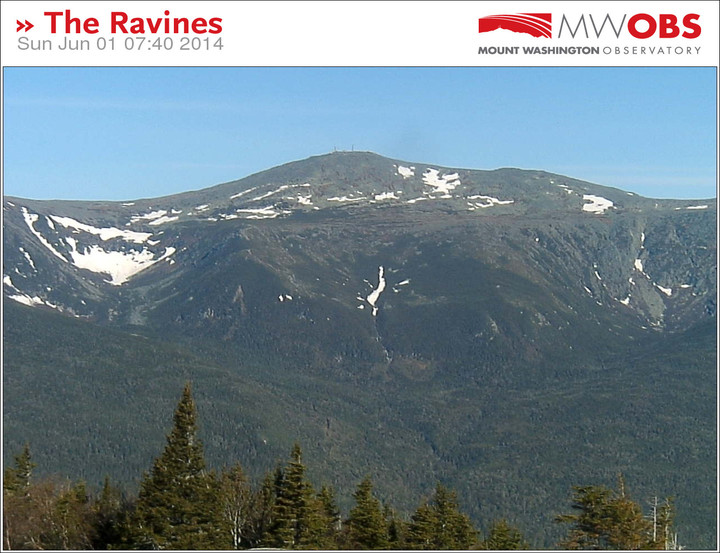
“The snowfield was a
totally clean slate of
corn, with no traces
of previous skier
activity…”
Today the traverse out to the snowfield was incredibly quick – within 5 to 10 minutes (Ty says it was 7 minutes) we’d hit the snow. The snowfield was a totally clean slate of corn, with no traces of previous skier activity, so presumably nobody had skied it in a while. The scene was quiet when we arrived, but it wasn’t long before the boys started having fun with the snow and the activity level ramped up. The boys had a great attitude about the skiing today, certainly relative to some trips we’ve had, and although it was different since Mom wasn’t there, I think they enjoyed the “boy’s day out” sort of feel. We made an initial ski descent of the snowfield, which seemed to provide somewhere in the range of 200 feet of vertical. It was a reasonably long run in which you could certainly get a groove going, and there were a lot of different options for skiing in the various nooks and crannies of the snowfield’s footprint. The snow was great, being a bit harder in a few spots, and a bit softer in others, but the bulk of it was just right for making turns. I told the boys that I’d bring their skis back up for them so that they could enjoy the hike, and strapped their skis on my pack along with mine. It actually wasn’t a bad pack load, and I think it helped to keep their spirits up.
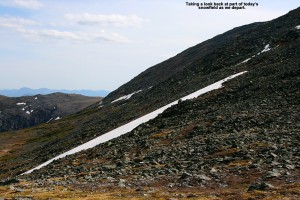
Back at the top of the snowfield, we had lunch, and the boys again played around in the snow for a while. There was just a bit of breeze at times, and bugs were virtually nonexistent, so it was a great day to be out on the snow. During our first run, a couple with a dog had arrived for some skiing, but they spent their time a little farther over on the snowfield, so we didn’t see them much. It was actually good that they had their own section in which to hang out, because Ty and Dylan were a bit boisterous in their play, and that way the boys weren’t too loud in their immediate vicinity. For our last run we decided to run out the snowfield to the bottom, then contour back over to the Huntington Ravine Trail and take that right back up to the car. That hike took a bit longer since we were starting out lower in elevation, but I’d say within roughly 15 minutes we were back at the parking area. The boys still played around a lot today, so that took up plenty of the afternoon, but this has to be our most efficient outing in terms of the hiking. The snow will likely be around for a bit longer based on what we saw, so there should be snowfield turns available for those that are interested as we move forward in June.
2012-2013 Ski Season Summary
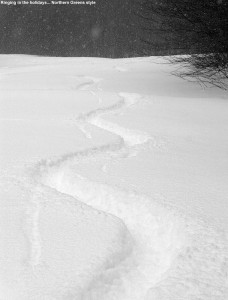
Our recently completed 2012-2013 Waterbury Winter Weather Summary, focused on how the snowfall and other aspects of winter transpired down at our house in the Winooski Valley, and now this report will focus on the skiing and snow in the higher elevations.
Snowfall: Compared to the snowfall-deficient 2011-2012 Ski Season, the 2012-2013 Ski Season was certainly a step up, but it was still generally below average for snowfall in the mountains of Northern Vermont. It was Bolton Valley that seemed to fare the worst of the northern resorts along the spine of the Green Mountains, perhaps due to their west slope location and this season’s dearth of upslope snow; they reported just 78.5% of their average snowfall. Heading northward, Stowe and Smugg’s fared a bit better at around 85% of average, and Jay Peak reported roughly average snowfall. Down at our house in the Winooski Valley, snowfall was 88.6% of average, so not too shabby by most accounts, but a bit below the mean like some of the local mountains. These past two seasons have actually been the first pair delivering back-to-back below average snowfall in our area since we started keeping track in 2006. Those numbers can be seen in both our Waterbury Winter Weather Summary Table, and the table of Bolton Valley annual snowfall below; this past season’s snowfall is highlighted in blue:
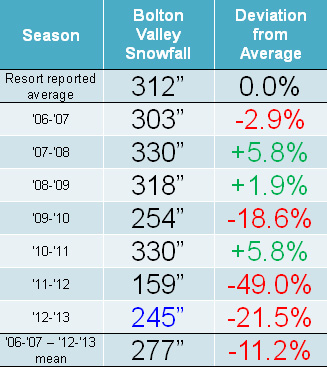
One item of note this season was the lack of big storms targeting Northern New England – two of the largest storms to hit the Northeast dropped the bulk of their payloads south of Vermont while exiting stage right toward the Atlantic. The first of those, nicknamed “Nemo”, hit in the second week of February, and pounded Southern New England with up to 40 inches of snow. The Green Mountains were on the northern fringe of that storm, but still wound up with 1 to 1.5 feet of snow up and down the spine. The other storm of note was during the March 5th – 8th period, and it dropped another 30 inches on some Southern New England locations, but nothing way up north. There were some periods of snowfall to highlight up in Northern Vermont however. The second half of December alone dropped almost 50” of snow down at our house, significantly more in the mountains, and produced some fantastic skiing for the holidays and into early January. Another period of note was the second half of March into April. Cold temperatures in the latter part of the season helped preserve wintry conditions on the slopes, and we received some decent snowfall as well – the largest storm for the season in my valley records hit the area near the end of March, with 21.3” of snow down at the house, and multiple feet for the mountains. The mountain snowpack finally responded during that late season stretch as well, and that’s detailed a bit more in the snowpack section below. Snowfall continued right into mid April, and the season was capped off with almost two feet of fresh snow on Mt. Mansfield for Memorial Day weekend. That was a sweet way to end the powder skiing for the season.
Snowpack: Aside from the spikes associated with a couple of early season storms, the mountain snowpack was below average going into mid December. That changed quickly though, with the onset of all that new snow during the second half of the month. The above average snowpack achieved during the holidays didn’t actually stay that way during January’s warmth and lack of storms. After consolidation, the snowpack generally trundled along at or below average through February’s continuation of relatively low snowfall. From mid February to mid March, the snowpack sat there essentially stagnant for an entire month; to wit, on February 21st, the snowpack was at 65”, and roughly a month later on March 18th, it was still at 65”, without any notable consolidation of more than a few inches. The late season stretch from mid March to mid April represented a nice rebound for the mountains however, with some quick gains from the big Northern New England March storm getting it above average, and the snow depth staying at least modestly above during the period.
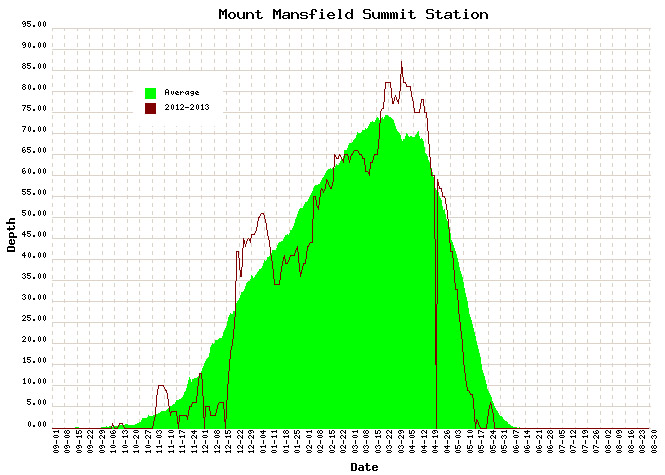
Tree Skiing: One metric used as a rough guide for the start of off piste skiing in the Northern Green Mountains is the point at which the snow depth reaches 24” at the Mt. Mansfield stake. For those unfamiliar with how this metric was established, it’s described in some detail in the 2011-2012 ski season summary. With the incorporation of this season’s data, the mean date remains at December 12th ± 19 days, with an average depth at the stake of 25.9 ± 2.7 inches. After the very slow start in 2011-2012, in which the 24” depth wasn’t attained until January 3rd (more than a standard deviation later than the mean), this past season was notably earlier. The plot below shows the date at which 24” was obtained for each season since 1954, with 2011-2012 shown in red, and 2012-2013 shown in green:
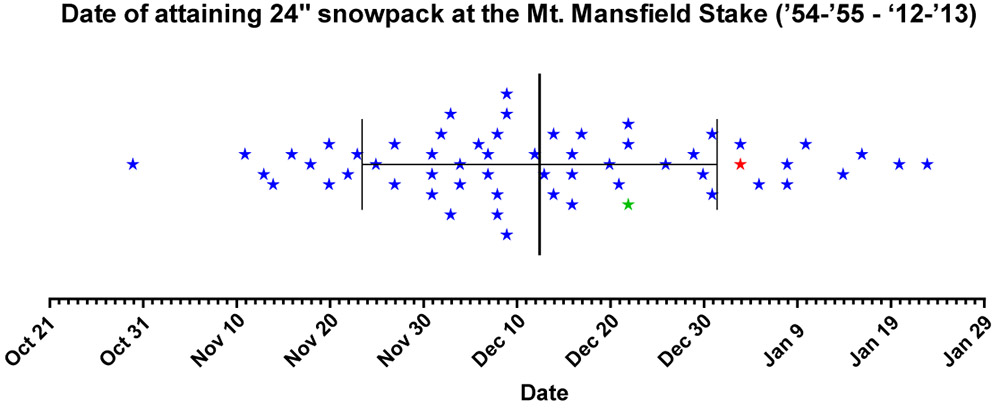
This past season, the date (December 22nd, Depth=28”, Green Star) was still later than average due in part to the slow first half of December, but unlike last season it was well within the 1 S.D. bars (thin vertical black lines). Note that the 24” mark is being used as an indicator of when the first forays into appropriate off piste/tree skiing terrain typically start in the Central and Northern Greens. In terms of empirical tree skiing observations, personal experience again lends some support to the use of 24” mark this season, as we began venturing into the trees the very next day on December 23rd at Bolton Valley. It should be noted though, that while the 24” mark was attained on December 22nd this season, the 40” mark was attained the very next day on December 23rd. The 40-inch rule (i.e. reaching a depth of 40” at the stake), is used as an indicator of when most off piste/tree skiing around here is ready to go. Although I haven’t looked into the data, this season has got to represent one of the quickest ascents from 24” to 40” – it’s interesting to note however that after rising to 42” of depth on December 23rd and 24th, the snowpack settled back to 36” for a couple of days before rebounding to 45” on the 27th.
Snow Quality: As an monitor of snow quality for the season, the chronological list of our ski outings has once again been compiled, with those days in which we were skiing powder indicated by a P, and those days in which powder skiing wasn’t available indicated by an X. The availability of powder suggests a fairly high level of snow quality, and the absence of powder generally indicates that temperatures rose above freezing at all elevations. Each listing below represents a link to the full report where images and more information from the outing can be obtained. Outings with an X may still be providing decent skiing such as wet snow, corn, etc. (or else skiing was typically avoided) but aside from the spring period, there’s going to be a price to pay in terms of snow quality associated with these episodes when temperatures eventually cool back down. The pattern of snow conditions in the Northern Green Mountains was fairly typical this past winter, with those days lacking powder skiing showing up in three distinct periods: 1) the early season with its usual temperature fluctuations, up through mid December before the weather pattern changed and the cold weather stabilized, 2) a thaw period in mid January, and 3) the period starting in mid March where spring weather began to make inroads. However, with the way the weather patterns this past spring continued to provide cool temperatures and snowfall, powder skiing generally dominated until mid April. Having analyzed the skiing in this way for the past three seasons, a surprising level of consistency is noted, with an overall average of close to four out of five days providing powder, despite notable differences in the demeanor of these recent ski seasons. The 2010-2011 season, which was above average in snowfall, provided powder on 78% of outings, the 2011-2012 season, which was well below average in many ways, revealed the same 78%, and most recently the 2012-2013 season, which was slightly below average in this area, produced a very similar 77% of outings with powder. The percentages don’t take into account differences in the number of outings each season, but with all three seasons falling into the range of 50 to 60 ski outings, differences in the sample sizes aren’t huge. The list of categorized ski outings with links to their full reports follows below:
P Stowe, VT, Sunday 04NOV2012
X Stowe, VT, Sunday 11NOV2012
X Stowe, VT, Thursday 15NOV2012
P Stowe, VT, Friday 30NOV2012
P Stowe, VT, Saturday, 01DEC2012
X Stowe, VT, Saturday, 15DEC2012
P Bolton Valley, VT, Friday 21DEC2012
P Bolton Valley, VT, Saturday 22DEC2012
P Bolton Valley, VT, Sunday 23DEC2012
P Bolton Valley, VT, Thursday 27DEC2012
P Bolton Valley, VT, Friday 28DEC2012
P Bolton Valley, VT, Saturday 29DEC2012
P Bolton Valley, VT, Saturday 29DEC2012 (Night)
P Bolton Valley, VT, Sunday 30DEC2012
P Bolton Valley, VT, Monday 31DEC2012
P Bolton Valley, VT, Tuesday 01JAN2013
P Bolton Valley, VT, Saturday 05JAN2013
P Stowe, VT, Sunday 06JAN2013
X Bolton Valley, VT, Saturday 12JAN2013
X Stowe, VT, Sunday 13JAN2013
P Bolton Valley Nordic & Backcountry, VT, Saturday 19JAN2013
P Stowe Sidecountry & Bruce Trail, VT, Monday 21JAN2013
P Bolton Valley Nordic & Backcountry, VT, Sunday 27JAN2013
P Bolton Valley, VT, Tuesday 29JAN2013
P Stowe, VT, Sunday 03FEB2013
P Bolton Valley, VT, Saturday 09FEB2013
P Stowe, VT, Sunday 10FEB2013
P Stowe, VT, Thursday 14FEB2013
P Bolton Valley & Backcountry, VT, Saturday 16FEB2013
P Bolton Valley & Backcountry, VT, Monday 18FEB2013
P Bolton Valley, VT, Thursday, 21FEB2013
P Bolton Valley, VT, Saturday 23FEB2013
P Stowe, VT, Sunday 24FEB2013
P Bolton Valley, VT, Tuesday 26FEB2013
P Bolton Valley, VT, Thursday 28FEB2013
P Bolton Valley & Backcountry, VT, Saturday 02MAR2013
P Stowe, VT, Sunday 03MAR2013
P Bolton Valley & Backcountry, VT, Saturday 09MAR2013
X Stowe, VT, Sunday 10MAR2013
P Bolton Valley, VT, Saturday 16MAR2013
P Stowe, VT, Sunday 17MAR2013
P Stowe, VT, Tuesday 19MAR2013
P Bolton Valley, VT, Thursday 21MAR2013
P Bolton Valley, VT, Thursday 21MAR2013 (Evening)
P Bolton Valley, VT, Saturday 23MAR2013
P Stowe, VT, Sunday 24MAR2013
P Bolton Valley, VT, Saturday 30MAR2013
X Stowe, VT, Sunday 31MAR2013
P Bolton Valley, VT, Tuesday 02APR2013
P Stowe & Mt. Mansfield Chin, VT, Saturday 06APR2013
X Stowe & Mt. Mansfield Chin, VT, Sunday 07APR2013
P Stowe, VT, Saturday 13APR2013
P Bolton Valley, VT, Sunday 14APR2013
X Stowe, VT, Saturday 20APR2013
X Stowe, VT, Sunday 21APR2013
X Bolton Valley, VT, Sunday 28APR2013
X Sugarbush, VT, Saturday 04MAY2013
X Stowe, VT, Sunday, 05MAY2013
X Mt. Washington, NH, Saturday 18MAY2013
P Stowe, VT, Sunday 26MAY2013
The detailed month-by-month synopsis of the season is next:
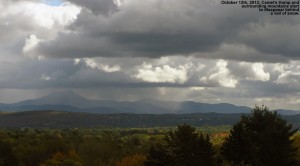 October: It wasn’t an especially snowy October to kick off the season; we had five rounds of snow in the mountains, and the third one even dropped accumulations to the lowest mountain valleys, but none of the storms were huge dumps, and we had just a tenth of an inch of snowfall down at the house for the month. October’s first snowstorm started up on the 7th, with snowfall being reported at the top of the Mt. Mansfield Toll Road in the afternoon, and by the next morning Powderfreak sent along his picture of 4” of accumulation at the top of the Stowe Gondola. I also got a shot of Mt. Mansfield later in the day with its first accumulation of the season. It didn’t seem like quite enough snow to tempt me out to ski, but the FIS boys hit the snow and provided a thorough report of the turns. The second storm delivered some accumulation on the 11th, with a snow line up around the 3,000’ level and less than an inch of snow found up on Mt. Mansfield. The third storm was the one that finally touched the lower valleys with some minimal accumulations, but in terms of mountain accumulations, I don’t think it was anything more than junkboarding material. The 4th (on the 14th of the month) and 5th (on the 16th of the month) storms of October also appeared to be pretty minimal and generally flew under the radar in terms of discussion. So while it wasn’t a great October for natural snow skiing (with nothing like the back-to-back larger storms at the end of October during the previous season), some folks made some turns and there were several smaller rounds of snow to keep the peaks white.
October: It wasn’t an especially snowy October to kick off the season; we had five rounds of snow in the mountains, and the third one even dropped accumulations to the lowest mountain valleys, but none of the storms were huge dumps, and we had just a tenth of an inch of snowfall down at the house for the month. October’s first snowstorm started up on the 7th, with snowfall being reported at the top of the Mt. Mansfield Toll Road in the afternoon, and by the next morning Powderfreak sent along his picture of 4” of accumulation at the top of the Stowe Gondola. I also got a shot of Mt. Mansfield later in the day with its first accumulation of the season. It didn’t seem like quite enough snow to tempt me out to ski, but the FIS boys hit the snow and provided a thorough report of the turns. The second storm delivered some accumulation on the 11th, with a snow line up around the 3,000’ level and less than an inch of snow found up on Mt. Mansfield. The third storm was the one that finally touched the lower valleys with some minimal accumulations, but in terms of mountain accumulations, I don’t think it was anything more than junkboarding material. The 4th (on the 14th of the month) and 5th (on the 16th of the month) storms of October also appeared to be pretty minimal and generally flew under the radar in terms of discussion. So while it wasn’t a great October for natural snow skiing (with nothing like the back-to-back larger storms at the end of October during the previous season), some folks made some turns and there were several smaller rounds of snow to keep the peaks white.
 November: Snowfall for the month of November turned out to be a bit below average down at our location in the valley, but we did have five storms that delivered accumulations all the way to the valley floor. It was a decent month for snowfall in the mountains, with Stowe reporting 35” in November. That’s not outrageous by any means, but it was a noticeable increase from the previous November. It was actually the first month with below average temperatures in Burlington in 20 months, and the corresponding mountain temperatures allowed Stowe to make a tremendous amount of snow. The rounds of November snows produced some modest powder that got me out early in the month on the 4th, and mid month on the 15th, but the best skiing was right at the month’s end. A storm overnight on the 29th dropped a foot of fresh fluff on the Northern Greens and then cleared out for some great turns by dawn patrol time. That new snow on top of previous rounds of accumulation delivered some fantastic bottomless powder skiing that held up even on steep terrain like Stowe’s National trail.
November: Snowfall for the month of November turned out to be a bit below average down at our location in the valley, but we did have five storms that delivered accumulations all the way to the valley floor. It was a decent month for snowfall in the mountains, with Stowe reporting 35” in November. That’s not outrageous by any means, but it was a noticeable increase from the previous November. It was actually the first month with below average temperatures in Burlington in 20 months, and the corresponding mountain temperatures allowed Stowe to make a tremendous amount of snow. The rounds of November snows produced some modest powder that got me out early in the month on the 4th, and mid month on the 15th, but the best skiing was right at the month’s end. A storm overnight on the 29th dropped a foot of fresh fluff on the Northern Greens and then cleared out for some great turns by dawn patrol time. That new snow on top of previous rounds of accumulation delivered some fantastic bottomless powder skiing that held up even on steep terrain like Stowe’s National trail.
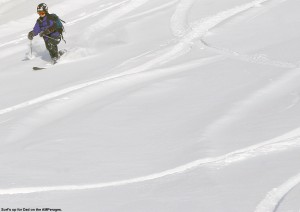 December: The great powder conditions from the end of November storm carried right over into the beginning of December, with some excellent skiing on the 1st of the month. That was really the highlight of the first half of December however, as snow was hard to come by through the 16th; we had just 2.2” of snow at the house during that period. It was as if a switch was flipped for the second half of the month though, with winter roaring back in to deliver almost 50” of snow for us in the valley. Some of the more significant storms during that stretch were on the 21st, with up to 20” of accumulation, the 26th, with over two feet, and the 29th, with another foot plus thrown in for good measure, so naturally the skiing during the holiday period was blissfully powdery. Even on days between the more substantial storms, a new half foot of snow could pop up. It was just day after day after day of powder, with even a little night added to the mix. The only detractor from that stretch was that the snowpack wasn’t initially up to the depths to allow people to enjoy that powder on all terrain. The natural base depths did make some quick and significant gains during the period though, with the 24” threshold depth at the Mt. Mansfield Stake being attained on the 22nd, and the 40” mark reached on the following day as described above in the section on tree skiing. Our first notable forays into the off piste were on the 23rd at Bolton Valley, which wasn’t surprising with almost all of Stowe’s terrain getting opened by that point. The off piste was quickly going… off, and things just went up from there. That storm on the 26th had a somewhat uncommon east wind, which filled in the Bolton Valley headwall areas for some fantastic coverage. Despite the relative scarcity of snowfall in the first half of the month, by the end of December, Stowe was at a respectable 102” of snow on the season.
December: The great powder conditions from the end of November storm carried right over into the beginning of December, with some excellent skiing on the 1st of the month. That was really the highlight of the first half of December however, as snow was hard to come by through the 16th; we had just 2.2” of snow at the house during that period. It was as if a switch was flipped for the second half of the month though, with winter roaring back in to deliver almost 50” of snow for us in the valley. Some of the more significant storms during that stretch were on the 21st, with up to 20” of accumulation, the 26th, with over two feet, and the 29th, with another foot plus thrown in for good measure, so naturally the skiing during the holiday period was blissfully powdery. Even on days between the more substantial storms, a new half foot of snow could pop up. It was just day after day after day of powder, with even a little night added to the mix. The only detractor from that stretch was that the snowpack wasn’t initially up to the depths to allow people to enjoy that powder on all terrain. The natural base depths did make some quick and significant gains during the period though, with the 24” threshold depth at the Mt. Mansfield Stake being attained on the 22nd, and the 40” mark reached on the following day as described above in the section on tree skiing. Our first notable forays into the off piste were on the 23rd at Bolton Valley, which wasn’t surprising with almost all of Stowe’s terrain getting opened by that point. The off piste was quickly going… off, and things just went up from there. That storm on the 26th had a somewhat uncommon east wind, which filled in the Bolton Valley headwall areas for some fantastic coverage. Despite the relative scarcity of snowfall in the first half of the month, by the end of December, Stowe was at a respectable 102” of snow on the season.
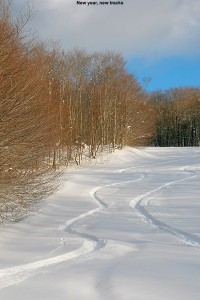 January: December’s snows and excellent ski conditions continued into the beginning of January, with four modest storms hitting the Northern Greens during the first week. In the higher elevations, the largest of those storms came in on January 4th and affected the northernmost resorts hardest, with a foot at Jay Peak. Even with somewhat lower totals at resorts to the south, the skiing remained quite good because of all the powder that had been building up over the previous three weeks – we found over a foot of powder lurking in the trees at Bolton Valley on the 5th. More snow came in that night to produce a nice day at Stowe on the 6th, and after the final snowfall event in the series, the snowpack at the Mt. Mansfield Stake stood at 51 inches on the 7th. The stormy stretch ended after that, and warm temperatures brought spring-like ski conditions until mid month. Fortunately, the base depths that had built up over the previous three weeks meant that there was a lot of good, soft skiing. Winter was back by mid month, with small systems that brought a return to some powder conditions. The fourth week of January featured arctic cold, which unfortunately meant little snowfall, but at least the temperatures preserved the powder. Finally at the end of the month we got a modest half foot storm to bring back some fresh powder, but January as a whole was quite low on snowfall – down at the house it was by far the least snowy January in my weather records.
January: December’s snows and excellent ski conditions continued into the beginning of January, with four modest storms hitting the Northern Greens during the first week. In the higher elevations, the largest of those storms came in on January 4th and affected the northernmost resorts hardest, with a foot at Jay Peak. Even with somewhat lower totals at resorts to the south, the skiing remained quite good because of all the powder that had been building up over the previous three weeks – we found over a foot of powder lurking in the trees at Bolton Valley on the 5th. More snow came in that night to produce a nice day at Stowe on the 6th, and after the final snowfall event in the series, the snowpack at the Mt. Mansfield Stake stood at 51 inches on the 7th. The stormy stretch ended after that, and warm temperatures brought spring-like ski conditions until mid month. Fortunately, the base depths that had built up over the previous three weeks meant that there was a lot of good, soft skiing. Winter was back by mid month, with small systems that brought a return to some powder conditions. The fourth week of January featured arctic cold, which unfortunately meant little snowfall, but at least the temperatures preserved the powder. Finally at the end of the month we got a modest half foot storm to bring back some fresh powder, but January as a whole was quite low on snowfall – down at the house it was by far the least snowy January in my weather records.
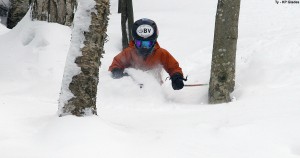 February: The month of February rolled in with a tempered return to the type of dry, arctic pattern that we’d encountered in that fourth week of January, but fortunately there was at least a bit more moisture and temperatures weren’t quite as cold. There wasn’t much new snow for the first weekend of the month, but at least the skiing was decent. Of the three storms that came in that following midweek, the second one brought from a half foot to nearly a foot of powder at some of the Northern Vermont resorts, so the skiing improved. Just in time for the next weekend, the “Nemo” storm hit the Northeast, and while it was largely a miss for Northern Vermont relative to areas to the south that got up to 40” of snow, the mountains still picked up more than a foot of powder to provide some excellent turns. Nemo was followed by a storm named “Orko”, which came in at the beginning of the following week with 1 to 1.5 feet for some of the local resorts. Beyond that storm, mid February was fairly dry, but powder conditions persisted, and on the 19th a more sizeable storm hit the area with snow totals of 1 to 2 feet plus for the Northern Vermont resorts. The month finished off with a few more storms, with a half foot storm and a 1 to 1.5-foot storm being the more notable ones. Although the month as a whole was actually rather lean on snowfall (only an inch from being the least snowy February in my records at the house), as it typical, the consistent availability of powder rolled right on into March as seen in the categorized list of ski outings above.
February: The month of February rolled in with a tempered return to the type of dry, arctic pattern that we’d encountered in that fourth week of January, but fortunately there was at least a bit more moisture and temperatures weren’t quite as cold. There wasn’t much new snow for the first weekend of the month, but at least the skiing was decent. Of the three storms that came in that following midweek, the second one brought from a half foot to nearly a foot of powder at some of the Northern Vermont resorts, so the skiing improved. Just in time for the next weekend, the “Nemo” storm hit the Northeast, and while it was largely a miss for Northern Vermont relative to areas to the south that got up to 40” of snow, the mountains still picked up more than a foot of powder to provide some excellent turns. Nemo was followed by a storm named “Orko”, which came in at the beginning of the following week with 1 to 1.5 feet for some of the local resorts. Beyond that storm, mid February was fairly dry, but powder conditions persisted, and on the 19th a more sizeable storm hit the area with snow totals of 1 to 2 feet plus for the Northern Vermont resorts. The month finished off with a few more storms, with a half foot storm and a 1 to 1.5-foot storm being the more notable ones. Although the month as a whole was actually rather lean on snowfall (only an inch from being the least snowy February in my records at the house), as it typical, the consistent availability of powder rolled right on into March as seen in the categorized list of ski outings above.
 March: The first half of March wasn’t especially snowy, with just one notable storm in the ½ to 1-foot range for the mountains; the big storm that affected southern parts of New England with up to 30 inches of snow in the March 5th-8th period was literally a non-event in Northern New England. Of course even with some warmer temperatures in the second week, decent powder remained in the higher elevations, and soft snow made for fun turns on piste. Around mid month though, the skiing started to get even better as the snowfall picked back up with back to back modest storms and 72-hour snow totals topping out around 16 inches on the 16th. Thanks to the ability of the Central and Northern Greens to reel in snow, conditions moved well beyond the dust on crust that many areas to the south were likely encountering. That was the start of an excellent stretch of winter that was second only to the snowy December period, with our largest valley storm of the season arriving on March 19th and delivering 7-day snow totals of 2 to 4 feet in the mountains. At Stowe they were calling it “Powder Week” and the deep turns just kept on coming. The increase in mountain snowpack during the period was notable in that it finally moved solidly above average and stayed there Simply put, even lift-served powder skiing was endemic on piste during that second half of March until a brief warm-up during the last couple of days of the month.
March: The first half of March wasn’t especially snowy, with just one notable storm in the ½ to 1-foot range for the mountains; the big storm that affected southern parts of New England with up to 30 inches of snow in the March 5th-8th period was literally a non-event in Northern New England. Of course even with some warmer temperatures in the second week, decent powder remained in the higher elevations, and soft snow made for fun turns on piste. Around mid month though, the skiing started to get even better as the snowfall picked back up with back to back modest storms and 72-hour snow totals topping out around 16 inches on the 16th. Thanks to the ability of the Central and Northern Greens to reel in snow, conditions moved well beyond the dust on crust that many areas to the south were likely encountering. That was the start of an excellent stretch of winter that was second only to the snowy December period, with our largest valley storm of the season arriving on March 19th and delivering 7-day snow totals of 2 to 4 feet in the mountains. At Stowe they were calling it “Powder Week” and the deep turns just kept on coming. The increase in mountain snowpack during the period was notable in that it finally moved solidly above average and stayed there Simply put, even lift-served powder skiing was endemic on piste during that second half of March until a brief warm-up during the last couple of days of the month.
 April: Despite the somewhat slow increases in the snowpack during the heart of the winter, the gains made during the latter half of March meant that the snowpack was at least modestly above average heading into April, and it quickly reached a peak of 87 inches at the Mt. Mansfield Stake when the first storm of the month dropped a foot of snow at Stowe on April 2nd. I was up at Bolton Valley that day for a ski tour, and I got to witness some impressive snowfall rates as the storm crashed into the higher elevations. The alpine terrain above tree line on Mt. Mansfield was in good shape, consistently providing excellent outings during that first part of the month. Cool temperatures with additional snow meant that the snowpack stayed at an above average level right through the month, and another storm on the 12th saw Ty and I enjoying close to a foot of dense powder out in the Bypass Chutes at Stowe on the 13th. The skiing gradually transitioned to full on spring conditions after that weekend as the active pattern waned, and an impressively long stretch of clear weather moved in and stuck around well into May.
April: Despite the somewhat slow increases in the snowpack during the heart of the winter, the gains made during the latter half of March meant that the snowpack was at least modestly above average heading into April, and it quickly reached a peak of 87 inches at the Mt. Mansfield Stake when the first storm of the month dropped a foot of snow at Stowe on April 2nd. I was up at Bolton Valley that day for a ski tour, and I got to witness some impressive snowfall rates as the storm crashed into the higher elevations. The alpine terrain above tree line on Mt. Mansfield was in good shape, consistently providing excellent outings during that first part of the month. Cool temperatures with additional snow meant that the snowpack stayed at an above average level right through the month, and another storm on the 12th saw Ty and I enjoying close to a foot of dense powder out in the Bypass Chutes at Stowe on the 13th. The skiing gradually transitioned to full on spring conditions after that weekend as the active pattern waned, and an impressively long stretch of clear weather moved in and stuck around well into May.
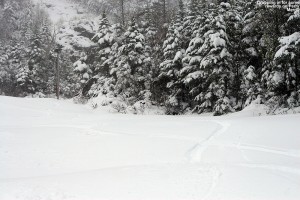 May: For most of May, there wasn’t much to talk about in terms of new powder, especially with the extended period of incredibly clear weather that carried over from the end of April and lasted a fortnight, finally ending on the 10th of the month. There was some mighty fine spring skiing right through that period with all the sun and warm weather, even if it did cause the snowpack to decrease a bit faster than it otherwise might have. The tranquil period of warm weather allowed the Mt. Washington Auto Road to open on the 10th of the month as well (definitely on the early side), but since unsettled weather had just returned at that point, we didn’t get to make our spring pilgrimage to the snowfields until the 18th. To really cap the month off well, Northern New England and the Adirondacks were rewarded with a Nor’easter over Memorial Day Weekend, which delivered roughly 3 feet of powder to Whiteface and nearly 2 feet to Mt. Mansfield. Excellent powder turns were made while the valleys were almost fully leafed out for the spring. We didn’t actually head out for any June turns beyond that, but the skiing over Memorial Day Weekend had been so good that it hardly mattered – it was just a few short months until the snows of fall would be returning.
May: For most of May, there wasn’t much to talk about in terms of new powder, especially with the extended period of incredibly clear weather that carried over from the end of April and lasted a fortnight, finally ending on the 10th of the month. There was some mighty fine spring skiing right through that period with all the sun and warm weather, even if it did cause the snowpack to decrease a bit faster than it otherwise might have. The tranquil period of warm weather allowed the Mt. Washington Auto Road to open on the 10th of the month as well (definitely on the early side), but since unsettled weather had just returned at that point, we didn’t get to make our spring pilgrimage to the snowfields until the 18th. To really cap the month off well, Northern New England and the Adirondacks were rewarded with a Nor’easter over Memorial Day Weekend, which delivered roughly 3 feet of powder to Whiteface and nearly 2 feet to Mt. Mansfield. Excellent powder turns were made while the valleys were almost fully leafed out for the spring. We didn’t actually head out for any June turns beyond that, but the skiing over Memorial Day Weekend had been so good that it hardly mattered – it was just a few short months until the snows of fall would be returning.
So what about the overall feel for the quality of the ski season in Northern Vermont? Well, much like the snowfall numbers suggest, it feels like it came in a bit below average, even if not horribly so. The mountain snowpack (as gauged by what was seen at the stake on Mt. Mansfield) had its ups and downs, and on balance it probably gets rated in a similar manner to what the slightly subpar snowfall would suggest. Being frequent Bolton Valley skiers and living down below the mountain in the Winooski Valley, our perspective might be skewed a bit downward with the resort receiving just 78.5% of their average snowfall. Having the north miss out somewhat on a couple of big regional storms, while watching a horrid valley snowpack (see the 2012-2013 Winter Weather Summary for details) that kept ski routes to the lower valley bottoms essentially off the table, certainly didn’t win the season any extra points. It seems that 2012-2013 ultimately sits in the lower half of ski seasons and won’t be remembered as anything epic, but it also appeared to hold onto a decent level of powder availability (77%) based on our experiences, and that means there was still a pretty decent amount of good skiing. The fact that even the poor 2011-2012 Ski Season was able to hold onto a powder percentage in that range is also reassuring in that regard, suggesting that there is indeed a certainly level of reliability that can be expected in these seasons where snowfall/snowpack is below average.
Mt. Washington, NH 18MAY2013

Using the Auto Road to gain access to Mt. Washington’s East Snowfields is a convenient way to get to some fantastic spring skiing, but a number of factors need to align for an optimal outing to come together. First, the road has to open. One never knows exactly when that’s going to happen, since it depends on how much snow has to be removed, how fast it’s melting, how much road maintenance needs to be done, how often bad weather delays work, etc. Then, even once the road is open, weather can still play a factor. Although some folks might be inclined to head up into the alpine regardless of the forecast, I think most folks would agree that a calm, warm, clear spring day (or at least as close as you can get to that ideal) is the way to go. Those types of days can be rare on Mt. Washington, but they certainly happen, and they typically occur more frequently the farther one gets into late spring. While time might be on your side with regard to weather, it’s generally not on your side when it comes to snowpack. With each passing day of warmth, the snowpack melts a little more, and ski options diminish. Unlike when you get an iceland camper rental over there, the snow isn’t lasting quite so long these days over here. And, even if the stars align to create that perfect combination of access, weather and snowpack on the mountain, there’s everything else in life that has the potential to get in the way of letting you jump at the opportunity. Once in a while, things just don’t come together before the snow melts, but somehow, even with all those obstacles, we usually manage to get over to New Hampshire for some spring camping and skiing with the boys, and this year was no exception.
“We had the snowfield
to ourselves the entire
afternoon…”
For two weeks from the end of April through to the second week of May, we saw an incredible stretch of clear, warm spring weather with absolutely no measurable precipitation at our house in Waterbury. This period produced some great spring skiing, but the warmth and sun also accelerated the snowmelt to a rate that was a bit faster than usual. This period was great in terms of progress on clearing snow from the Mt. Washington Auto Road however, and it was open to the summit as of last weekend. The weather was unsettled for that first weekend though, so we opted to head down to the South Shore area and visit Erica’s mom for Mother’s Day, and keep our eyes peeled for a good weather window. After a couple more days of unsettled weather, the clear regime returned this week, and prospects for an Auto Road trip were looking excellent. This morning, the forecast called for decent weather with temperatures in the 40s F, and the morning shot from the Ravines Cam revealed crystal clear skies. It also showed that the east side ski options below the Mt. Washington summit are still quite plentiful, with many additional snowfields available along with the main one.
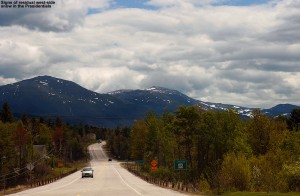
We were on our way to the mountain by mid morning, and views from the west side were already encouraging as we approached the Presidentials. When the west side still has skiable snow, you know the east side is going to have plenty of options. Steep lines with decent snow were even visible on the north side of the range as we passed by on Route 2, and on the ascent of the Auto Road we could see various snowfields in the peaks towering above the Great Gulf. In the proximity of the Auto Road itself, the first signs of snow were at roughly the 3,500′ elevation. As for the East Snowfields, the setup today was a lot like we encountered during our 2010 trip, in that the broad strip of snowfields was present off to the north of the main East Snowfield. A look at the availability of snow in 2010 shows an interesting distribution of snow – that strip of snowfields off to the north was very prominent, and the main East Snowfield was surprisingly small. The current snowpack is definitely different from what we had available on our 2011 and 2012 trips, where the skiing was essentially down to just the main snowfield.
“The snowfield held
beautifully flat and
pristine corn snow…”
With the lower snowfields in action, we decided to go with the approach applied in our 2010 trip, which is to use the parking area below the 7-mile post on the road, instead of the parking area at the top of the snowfields. Using this technique, one can tour out along the more northerly snowfields as far as they want, even hitting the main East Snowfield if they’d like. Then, to finish the tour, instead of having to hike back up to the parking area atop the East Snowfield, one can essentially traverse back along the base of the snowfields with minimal additional ascent. Along the way, you can make descents in the other snowfields as well, which often have untouched snow. They’re used much less than the main East Snowfield and we’ve typically found that we have them to ourselves with untouched corn snow. At the end of our 2010 trip, we also discovered a very efficient use of the mountain’s hiking trail network for this type of tour. We’ve started traversing on the Nelson Crag Trail before, but, it turns out that simply descending straight down from the lower parking area on the Huntington Ravine Trail drops you right onto the northern edge of the snowfields, so you can use the trail to get you right to the snow. You can’t really see the snow from above, so it’s not obvious unless you know what you’re doing, but as long as those northerly extensions of the snowfield are present, it’s a really sweet and efficient approach. Even though the distribution of the snow in the snowfields area is different each spring, it’s nice to be developing a knowledge of what works well for getting to the snow. We’re definitely starting to dial in a good understanding of how to best approach what we see on the Ravines Cam in terms of touring the snowfields. This year our goal was to tour out toward the main East Snowfield as described above, with the potential to ski there, but it would depend on how good the skiing was that found along the way, as well as time, and of course the boy’s attitude and morale, which can be extremely flighty on these outings.
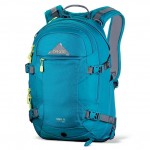 As expected, taking the Huntington Ravine Trail got us to the snow in just a few minutes of hiking from the car, and Ty and Dylan were ready to just stop right there and start skiing. E and I explained to them that what they saw was just the tip of the iceberg in terms of snow, and that we would be traversing southward for some longer lines. The snowfield there was only about 50 vertical feet or so, but typically the priority for the boys is to minimize the amount of hiking they have to do in whatever way they can. The boys did have a bit more challenge this year, since they were both carrying their own skis on their packs for the first time. Fortunately, they had both decided to use their Telemark skis, also a first for them, so it’s nice that their Teles are lighter than their alpines. This also meant that they could simply wear their Telemark boots and hike like me and Erica in ours, since they are very flexible and have rubber soles. This meant we didn’t have any alpine boots to carry, although Tele boots still aren’t quite as easy for hiking as standard hiking boots, so that was a bit of a bump in challenge for the boys. For E, this trip was also a chance to carry her skis on the Dakine Women’s Pro II 26L ski pack that she got for Christmas. Although she used it on some backcountry outings this winter, we were always skinning, so there was no need to carry her skis on her back. This was her first opportunity to really put it to the test with skis on it, and she was very impressed. I wouldn’t have thought about it, except that she commented on how it didn’t even feel like she had skis on her back – that’s always good sign when it comes to a ski pack. She also mentioned how the diagonal carry is so superior to the A-frame style carry in terms hitting the backs of the skis with your legs. I’ve always been very impressed with the diagonal carry on my Dakine Sequence ski/photo pack, so I’m glad E is getting to make use of that system. Dakine definitely knows how to set up a ski carry system. The one issue I did notice with E’s pack is that since it has a helmet carrying system (very cook and I wish I had one) it gets a bit tight when the skis are on there in diagonal carry as well. Overall the skis and helmet were nice and snug there though, and E had no complaints. Our only lament heading outbound on the tour was that with our skis angled down to the right, it meant that they occasionally touched the rocks because of the direction of the side slope on our southward traverse. It was only an occasional inconvenience though, and I joked that we could always traverse around the entire Mt. Washington summit cone in the other direction if we really wanted to avoid that issue ;).
As expected, taking the Huntington Ravine Trail got us to the snow in just a few minutes of hiking from the car, and Ty and Dylan were ready to just stop right there and start skiing. E and I explained to them that what they saw was just the tip of the iceberg in terms of snow, and that we would be traversing southward for some longer lines. The snowfield there was only about 50 vertical feet or so, but typically the priority for the boys is to minimize the amount of hiking they have to do in whatever way they can. The boys did have a bit more challenge this year, since they were both carrying their own skis on their packs for the first time. Fortunately, they had both decided to use their Telemark skis, also a first for them, so it’s nice that their Teles are lighter than their alpines. This also meant that they could simply wear their Telemark boots and hike like me and Erica in ours, since they are very flexible and have rubber soles. This meant we didn’t have any alpine boots to carry, although Tele boots still aren’t quite as easy for hiking as standard hiking boots, so that was a bit of a bump in challenge for the boys. For E, this trip was also a chance to carry her skis on the Dakine Women’s Pro II 26L ski pack that she got for Christmas. Although she used it on some backcountry outings this winter, we were always skinning, so there was no need to carry her skis on her back. This was her first opportunity to really put it to the test with skis on it, and she was very impressed. I wouldn’t have thought about it, except that she commented on how it didn’t even feel like she had skis on her back – that’s always good sign when it comes to a ski pack. She also mentioned how the diagonal carry is so superior to the A-frame style carry in terms hitting the backs of the skis with your legs. I’ve always been very impressed with the diagonal carry on my Dakine Sequence ski/photo pack, so I’m glad E is getting to make use of that system. Dakine definitely knows how to set up a ski carry system. The one issue I did notice with E’s pack is that since it has a helmet carrying system (very cook and I wish I had one) it gets a bit tight when the skis are on there in diagonal carry as well. Overall the skis and helmet were nice and snug there though, and E had no complaints. Our only lament heading outbound on the tour was that with our skis angled down to the right, it meant that they occasionally touched the rocks because of the direction of the side slope on our southward traverse. It was only an occasional inconvenience though, and I joked that we could always traverse around the entire Mt. Washington summit cone in the other direction if we really wanted to avoid that issue ;).
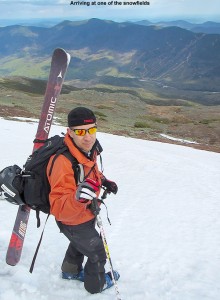
After only about ten minutes of southward traversing, we came to a substantial snowfield of about 250′ vertical or so, and we decided to do some skiing. We hit the snowfield about midway up, so I set in a boot ladder to the top. The snowfield held beautifully flat and pristine corn snow, aside from a couple of very faint tracks from a previous skier or two that must have been there quite a while ago. The snowfield was continuous, but did have a choke point about midway down along the left, so one had to take that route.
It was good that we’d reached at least an initial snowfield, because the boys were already getting grumpy. They really wanted to get on with the camping. They’d been planning that aspect of the trip for a long time, looking on sites like campingfunzone.com for handy tips and tricks which they were now dying to try out, so while they enjoy being out on the snow, getting them to thoroughly relish all aspects of earned turns is always a challenge. They got out their flashlights for hiking when it got dark, and loved the setup and maintaining the fire, and other tasks like that. Some days they enjoy the experience, or at least substantial parts of it, but other times it’s essentially putting up with Mom and Dad dragging them around to these snowy spots. We’ve learned that it’s good to have a “carrot” aspect of the trip as well, whether it’s a stop in a the Bryant Cabin on a Bolton Valley Backcountry Network outing or the swimming pool after, a chance to eat out somewhere once we’re done, or in this case, a chance to do some camping. We relayed to them that they were sitting on their own private snowfield with great temperatures, no wind, no bugs, beautiful snow, and even some sunshine. These aren’t things that you can get every day, but in their minds they were already off the mountain and down by the tent and campfire.
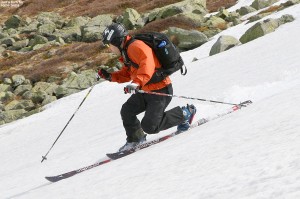
At the top of the snowfield, I hung out for a while and enjoyed the scene, while the boys did a bit of sliding on the snowfield, and E made the first descent. Her turns looked good, and it was amazing how fast she dropped that vertical. It seemed like she was down toward the flats of the Alpine Garden area in an instant, and she looked so far away. I skied a run next, and then we eventually got the boys to make some turns, even though they were being somewhat lazy and reluctant. They both put together some nice Telemark turns, even though the pitch of the snowfield was quite steep. E and I both made some additional turns, with me finishing off a run on the lower right of the snowfield while E shot some pictures. We had the snowfield to ourselves the entire afternoon, so even though it was only about half the vertical of what was available on the main East Snowfield, it was such good skiing that we never even continued over there. The boys were a bit too sour for that anyway, and really wanted to get on to the camping. We could hear that occasional shout from people on the main snowfield though, and I’m sure there were some great times going on over there.

The return traverse to the car was pretty quick, and E and I helped out the boys by each carrying a pair of their skis. For the extra set of skis, we went with a vertical carry, and E seemed to still be impressed with the stability and ease of her pack, even with the second set of skis on it. I made the lowest traverse, so that meant a few minutes of hiking back up the Huntington Ravine Trail at the end, but I was eager to test that out. It was nice to walk on an established trail, since the going was a big quicker than across the random jumbles of rocks that give the Rock Pile its name. While we were loading up the gear at the parking area, we had some inquiries about where we’d been skiing, and one guy was very intrigued to know that you could access the snowfield from that lower parking lot. He said he’d like to try it out in the future.
“…but in their minds
they were already off
the mountain and down
by the tent and campfire.”
Each year we like to try out a new campground on our visit to the snowfields, and this year I decided that we’d head south to Glen, New Hampshire. I’d found a couple of potential campgrounds there. The first was the Green Meadow Camping Area, but when we stopped in and found out that they weren’t opening until next weekend, we headed to the Glen Ellis Family Campground a couple of miles down the road. I’d put it as the second choice because it was a bit more expensive, but once we got there you could immediately tell why. The grounds are immaculate, and the building that functions as the main office and store was a beautiful building. Everything was first rate, and they’ve got a huge playground, basketball and tennis courts, and even a pristine baseball diamond. It’s certainly in that upper echelon of campgrounds.
Visitation was only modest since it’s no Memorial Day yet, so they gave us one of the riverside campsites. We thought that would be nice, but it wasn’t until we finally got to it that was saw how amazing it was – it was absolutely one of the coolest campsites we’ve ever had in either to Eastern or Western U.S. There’s a wooded section with the usual fire ring, picnic table, etc., but then that expands up onto a riverside area comprised of the rocks that are part of the riverbed, with a second fire ring. It overlooks a gorgeous stretch of the Saco River that made E and I feel like we were back in Jasper National Park. As soon as we saw that riverside section, we knew we were going to pitch our tent right up there. The boys headed off to the playground for a bit, we cooked up some hot dogs and beans for dinner, and finished things off with s’mores and lot of campfire time. There wasn’t actually anyone else camping out on the river since campground visitation was light, but I have to believe those riverside spots are pretty coveted on busy weekend. The fly fishing looked amazing, and we saw one guy out working the stream about a half mile downstream. That is a campsite that will not soon be forgotten, and it will definitely be on our list for the next time we’re in the area. Apparently their Laundromat is a big deal as well, because there are as many signs for that as there are for the campground itself!
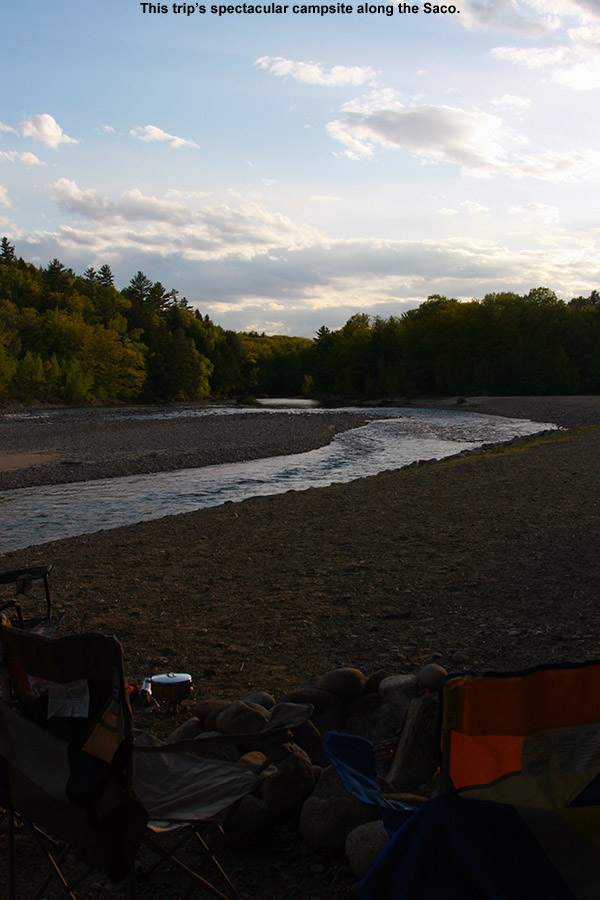
 Sunday update: The evening sky had some on and off broken clouds and a nice moon, and I bet it dropped into the 30s F overnight because even with the rain fly on the tent, we were down to the mid 40’s F. After breaking camp, we decided to try out one of the local restaurants for breakfast on the way home, and found the Glen Junction Family Restaurant. It definitely seemed to be the hot spot for breakfast, and the menu was almost overwhelming with the variety of combinations of fresh toast, omelets, and most of the usual morning fare that you can think of. Not surprisingly with the junction location, the theme is trains, and they’ve got some fairly large-scale trains that circulate around the rooms up near the ceiling. The boys definitely enjoyed watching those, as did the numerous children that were there as well – especially the younger ones. Of course any adults like me would enjoy them as well. One of the specials had eggs Benedict on French toast, which was tempting, although I ended up making my own omelet which contained corned beef hash and spinach. The waitress said that was the first time she’d ever had anyone put together that specific combination, and it turned out great. Everyone liked their fare, and we even had some extra to take home as the portions are plentiful.
Sunday update: The evening sky had some on and off broken clouds and a nice moon, and I bet it dropped into the 30s F overnight because even with the rain fly on the tent, we were down to the mid 40’s F. After breaking camp, we decided to try out one of the local restaurants for breakfast on the way home, and found the Glen Junction Family Restaurant. It definitely seemed to be the hot spot for breakfast, and the menu was almost overwhelming with the variety of combinations of fresh toast, omelets, and most of the usual morning fare that you can think of. Not surprisingly with the junction location, the theme is trains, and they’ve got some fairly large-scale trains that circulate around the rooms up near the ceiling. The boys definitely enjoyed watching those, as did the numerous children that were there as well – especially the younger ones. Of course any adults like me would enjoy them as well. One of the specials had eggs Benedict on French toast, which was tempting, although I ended up making my own omelet which contained corned beef hash and spinach. The waitress said that was the first time she’d ever had anyone put together that specific combination, and it turned out great. Everyone liked their fare, and we even had some extra to take home as the portions are plentiful.
We got home today around noontime, after a bit of maintenance on the mowers, I was able to do the first lawn mowing of the season. It’s only about four short months until I’ll be on the last mowing of the season, and we’ll be thinking about the first snows, but there are plenty of summer activities to do in the meantime. In terms of skiing, we’ll have to see if we want to take a trip down to Killington for some turns in the next couple of weeks, since they’re apparently going for June this year just like old times.

